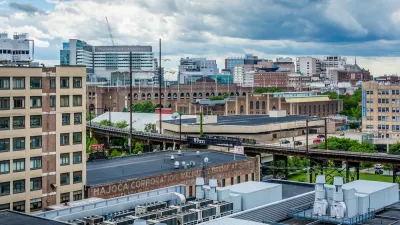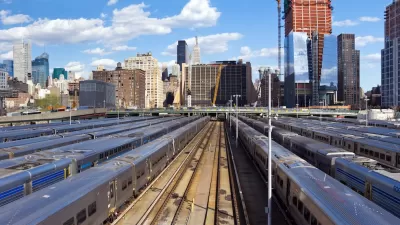The report recommends making displacement prevention a more central component of land-use policy.

"Displacement is often reported as individual battles over affordable housing or new development," notes Audrey Wachs in The Architect's Newspaper. But a new report from the Regional Plan Association takes a wider lens on the ongoing trend of displacement in the tri-state area around New York City.
Pushed Out: Housing Displacement in an Unaffordable Region found that in "desirable, central city neighborhoods," the number of households earning less than $100,000 a year has diminished by 2 percent, while the prevalence of households making over $100,000 has increased by 11 percent.
Data shows that throughout New York metropolitan area, wealthier (and whiter) people are replacing people of color in dense, central city neighborhoods with good transit access. There are, the RPA estimates, 990,000 people in the region who are at-risk of displacement; more than two-thirds of this group are Black or Latino.
Some municipalities have taken measures to curb the gentrification spurred by transit-oriented development; Jersey City, for example, has begun offering incentives for residential development outside of transit-rich areas. But the study notes that it can be difficult to fund affordable housing when federal standards for "affordability" don't align with local needs, and recommends other policy approaches cities could take to ensure affordability and prevent displacement, Wachs reports.
To ease the rising cost of housing and keep low-income residents in place, Pushed Out proposes policies like deeper rental subsidies, broader affordability ranges, centering displacement risk into land-use, and more legal protections for tenants, especially around eviction prevention and in areas outside of New York City where rent protections are weak or non-existent.
FULL STORY: A new report shows how sky-high housing costs fuel displacement in the tristate area

Study: Maui’s Plan to Convert Vacation Rentals to Long-Term Housing Could Cause Nearly $1 Billion Economic Loss
The plan would reduce visitor accommodation by 25,% resulting in 1,900 jobs lost.

Alabama: Trump Terminates Settlements for Black Communities Harmed By Raw Sewage
Trump deemed the landmark civil rights agreement “illegal DEI and environmental justice policy.”

Why Should We Subsidize Public Transportation?
Many public transit agencies face financial stress due to rising costs, declining fare revenue, and declining subsidies. Transit advocates must provide a strong business case for increasing public transit funding.

Paris Bike Boom Leads to Steep Drop in Air Pollution
The French city’s air quality has improved dramatically in the past 20 years, coinciding with a growth in cycling.

Why Housing Costs More to Build in California Than in Texas
Hard costs like labor and materials combined with ‘soft’ costs such as permitting make building in the San Francisco Bay Area almost three times as costly as in Texas cities.

San Diego County Sees a Rise in Urban Coyotes
San Diego County experiences a rise in urban coyotes, as sightings become prevalent throughout its urban neighbourhoods and surrounding areas.
Urban Design for Planners 1: Software Tools
This six-course series explores essential urban design concepts using open source software and equips planners with the tools they need to participate fully in the urban design process.
Planning for Universal Design
Learn the tools for implementing Universal Design in planning regulations.
Smith Gee Studio
Alamo Area Metropolitan Planning Organization
City of Santa Clarita
Institute for Housing and Urban Development Studies (IHS)
City of Grandview
Harvard GSD Executive Education
Toledo-Lucas County Plan Commissions
Salt Lake City
NYU Wagner Graduate School of Public Service





























